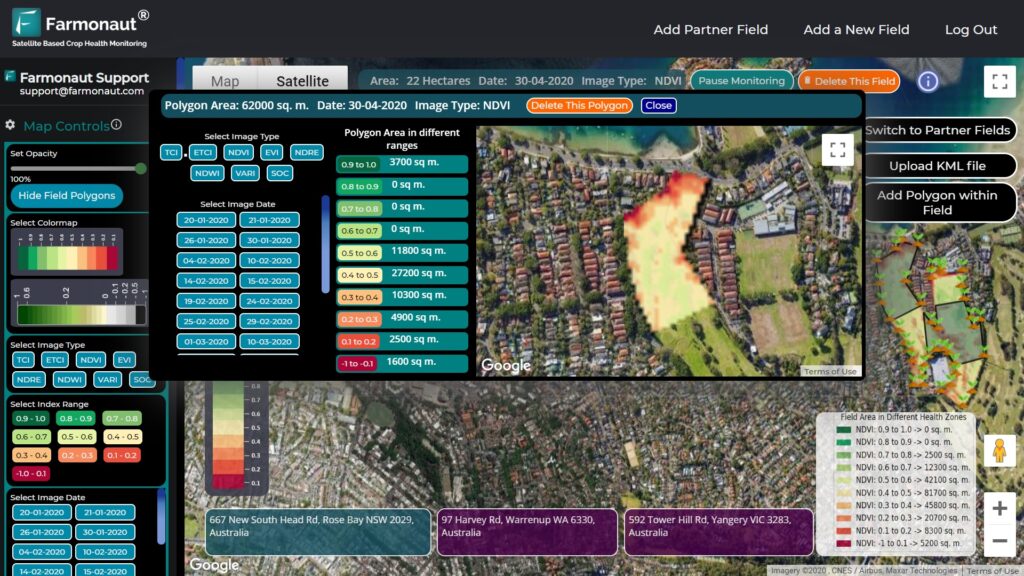Unlocking Nebraska’s Agricultural Profitability: Latest Trends in Land Management and Cash Rental Rates for 2025

“Nebraska’s agricultural economists host quarterly webinars, with the next one on February 17, 2025, focusing on land management trends.”
As we approach the 2025 growing season, the agricultural landscape in Nebraska continues to evolve, presenting both challenges and opportunities for landowners and operators alike. We at Farmonaut understand the importance of staying ahead of these trends, which is why we’re excited to share insights about an upcoming webinar that promises to shed light on the latest developments in agricultural land management and cash rental rates in the Cornhusker State.
The Importance of Staying Informed in Nebraska’s Agricultural Sector
Nebraska’s agricultural sector is a cornerstone of the state’s economy, and staying informed about the latest trends in land management and cash rental rates is crucial for maintaining profitability. The University of Nebraska-Lincoln’s Center for Agricultural Profitability recognizes this need and has organized a timely webinar to address these critical issues.
Set for February 17, 2025, at noon Central, this Land Management Quarterly webinar is part of an ongoing series designed to keep agricultural stakeholders up-to-date with the most current information and strategies. Whether you’re a seasoned farmer, a new landowner, or an agribusiness professional, this webinar offers valuable insights that could impact your bottom line.
What to Expect from the Webinar
The upcoming webinar will cover a range of topics crucial to understanding and navigating the agricultural landscape in Nebraska for 2025. Here’s what participants can look forward to:
- Cash Rental Rate Trends: An in-depth look at how cash rental rates are changing across different regions of Nebraska.
- Evolving Farm Lease Agreements: Insights into new considerations for lease agreements that reflect current market conditions.
- Flex Leasing Options: Exploration of flexible leasing arrangements that can benefit both landowners and operators.
- Strategies for Updating Rental Arrangements: Practical advice on how to adjust existing agreements for the 2025 growing season.
- Nebraska Farm Real Estate Market Analysis: A comprehensive overview of current trends and future projections.
This webinar is not just about presenting information; it’s about providing actionable insights that can help stakeholders make informed decisions about their agricultural investments and operations.
The Experts Behind the Webinar
Leading the webinar are two esteemed professionals from the Department of Agricultural Economics:
- Jim Jansen: With extensive experience in agricultural finance and land economics, Jansen has been at the helm of the Nebraska Farm Real Estate Market Survey and Report for several years.
- Anastasia Meyer: An agricultural economist specializing in rental negotiations, Meyer brings invaluable expertise that is relevant to both landowners and operators.
These experts will not only present the latest data and trends but also offer their interpretations and predictions for the future of Nebraska’s agricultural sector.
Interactive Q&A: Your Chance to Get Expert Advice
One of the most valuable aspects of this webinar is the interactive “Ask the Experts” segment. This portion of the event allows participants to engage directly with the presenters, asking specific questions about land management, leasing, or any other related topics. It’s an opportunity to get personalized advice from leading agricultural economists, tailored to your unique situation.

“The 2025 Nebraska agricultural webinar will cover evolving farm lease agreements, including flex leasing options for the upcoming growing season.”
Why This Webinar Matters for Nebraska’s Agricultural Community
As Jim Jansen emphasizes, “This webinar will help anyone with a vested interest in land to better understand the financial and human forces reshaping the rural agricultural landscape.” This statement underscores the webinar’s significance in today’s rapidly changing agricultural environment.
Understanding these forces is crucial for several reasons:
- Informed Decision-Making: Knowledge of current trends allows for better-informed decisions about land purchases, sales, or leasing arrangements.
- Maximizing Profitability: Insights into cash rental rates and leasing options can help both landowners and operators optimize their financial returns.
- Adapting to Change: As the agricultural landscape evolves, staying informed helps stakeholders adapt their strategies accordingly.
- Long-Term Planning: Understanding market trends aids in developing sustainable, long-term plans for agricultural operations.
Leveraging Technology in Agricultural Land Management
While the webinar focuses on traditional aspects of land management and leasing, it’s important to note how technology is revolutionizing these practices. At Farmonaut, we’re at the forefront of this technological revolution in agriculture. Our satellite-based farm management solutions offer valuable tools for both landowners and operators to make data-driven decisions.
For instance, our real-time crop health monitoring can provide crucial information for negotiating lease agreements or determining fair rental rates. By accessing accurate, up-to-date data on crop conditions, soil moisture levels, and other key metrics, both parties can make more informed decisions about land value and potential yields.
Furthermore, our API services allow for seamless integration of our satellite and weather data into existing farm management systems. This can be particularly useful for large-scale operations or agricultural consultants who need to analyze trends across multiple properties.
Nebraska Agricultural Land Rental Rates: A Comparative Analysis
To provide a clear picture of how agricultural land rental rates are changing in Nebraska, we’ve compiled a comparative table based on estimates for 2024 and 2025. This data aligns with the focus of the upcoming webinar and offers valuable insights for both landowners and operators.
| Land Type | Region | 2024 Average Rate ($/acre) | 2025 Estimated Rate ($/acre) | Percentage Change |
|---|---|---|---|---|
| Irrigated Cropland | Eastern Nebraska | 305 | 315 | +3.28% |
| Irrigated Cropland | Central Nebraska | 285 | 290 | +1.75% |
| Irrigated Cropland | Western Nebraska | 220 | 225 | +2.27% |
| Dryland Cropland | Eastern Nebraska | 210 | 215 | +2.38% |
| Dryland Cropland | Central Nebraska | 165 | 170 | +3.03% |
| Dryland Cropland | Western Nebraska | 75 | 77 | +2.67% |
| Pastureland | Eastern Nebraska | 60 | 62 | +3.33% |
| Pastureland | Central Nebraska | 45 | 46 | +2.22% |
| Pastureland | Western Nebraska | 15 | 15.5 | +3.33% |
This table provides a snapshot of the estimated changes in agricultural land rental rates across Nebraska. It’s important to note that these are average figures, and actual rates may vary depending on specific local conditions, soil quality, and other factors. The upcoming webinar will delve deeper into these trends and provide more nuanced analysis.
Key Takeaways from the Rental Rate Comparison
- Regional Variations: Eastern Nebraska consistently shows higher rental rates across all land types, reflecting the region’s generally higher productivity and proximity to markets.
- Modest Increases: The estimated rates for 2025 show modest increases across all categories, ranging from 1.75% to 3.33%.
- Irrigated vs. Dryland: Irrigated cropland commands significantly higher rental rates compared to dryland cropland, highlighting the value of reliable water access.
- Pastureland Trends: While pastureland rates are lower, they show similar percentage increases to cropland, indicating steady demand for grazing land.
These trends underscore the importance of staying informed about local and regional market conditions when negotiating lease agreements or making land management decisions.
The Role of Technology in Modern Agricultural Land Management
As we discuss these rental rates and land management trends, it’s crucial to highlight how modern technology is transforming the way we approach agriculture. At Farmonaut, we’re committed to making precision agriculture accessible and affordable to farmers of all scales.
Our satellite-based crop health monitoring system provides valuable insights that can inform decisions about land value, rental rates, and management practices. By leveraging this technology, both landowners and operators can:
- Make data-driven decisions about crop selection and rotation
- Optimize resource allocation, potentially reducing input costs
- Monitor crop health in real-time, allowing for timely interventions
- Assess the effectiveness of different management practices over time
These capabilities can be particularly valuable when negotiating flexible lease agreements or determining fair rental rates based on actual productivity rather than historical averages.
The Future of Agricultural Land Management in Nebraska
As we look towards the future of agricultural land management in Nebraska, several key trends are emerging:
- Increased Use of Flex Leasing: With volatile commodity prices and input costs, flexible leasing arrangements are becoming more popular. These agreements allow for adjustments based on actual yields or market prices, sharing both risks and rewards between landowners and operators.
- Focus on Sustainability: There’s growing interest in sustainable farming practices, which can impact both land management strategies and rental agreements. Landowners may offer incentives for conservation practices or soil health improvements.
- Technology Integration: As precision agriculture tools become more accessible, their use is likely to become a standard consideration in land management and lease negotiations.
- Changing Demographics: With an aging farmer population and increasing interest from non-farming investors, the dynamics of land ownership and management are evolving.
The upcoming webinar will undoubtedly delve into these trends, providing valuable insights for navigating this changing landscape.
Maximizing Agricultural Profitability: Strategies for Landowners and Operators
While understanding market trends is crucial, it’s equally important to implement strategies that can help maximize profitability. Here are some approaches that both landowners and operators might consider:
- Regular Communication: Maintain open lines of communication between landowners and operators to address concerns and opportunities promptly.
- Data-Driven Decision Making: Utilize tools like Farmonaut’s satellite-based monitoring to make informed decisions about crop management and resource allocation.
- Explore Alternative Lease Structures: Consider options like flex leases or crop-share arrangements that align interests and share risks.
- Invest in Soil Health: Long-term investments in soil health can increase productivity and land value over time.
- Stay Informed: Regularly participate in educational opportunities like the upcoming webinar to stay abreast of market trends and best practices.
By implementing these strategies and staying informed about market trends, both landowners and operators can work towards maximizing the profitability of their agricultural endeavors.
The Impact of Climate Change on Agricultural Land Management
As we discuss trends in agricultural land management, it’s impossible to ignore the growing impact of climate change. This global phenomenon is influencing farming practices, crop choices, and land values across Nebraska. The upcoming webinar is likely to touch on this critical issue, but let’s explore some key points:
- Shifting Growing Seasons: Changes in temperature and precipitation patterns are altering traditional growing seasons, which can impact crop selection and management practices.
- Water Management: With increasing concerns about water scarcity, efficient irrigation practices and water rights are becoming even more crucial in land valuation and management.
- Extreme Weather Events: The increased frequency of extreme weather events like droughts, floods, and severe storms is affecting risk assessments in agricultural operations.
- Adaptation Strategies: Landowners and operators are increasingly looking for ways to adapt to these changing conditions, which may involve new crop varieties, altered planting schedules, or improved soil management practices.
At Farmonaut, we recognize the importance of adapting to these changes. Our satellite-based monitoring system can help track these environmental shifts over time, providing valuable data for long-term planning and adaptation strategies.
The Role of Government Policies in Agricultural Land Management
Government policies play a significant role in shaping the agricultural landscape, including land management practices and rental markets. The upcoming webinar may touch on recent policy changes or proposed legislation that could impact Nebraska’s agricultural sector. Some areas to watch include:
- Conservation Programs: Policies that incentivize conservation practices can influence land management decisions and potentially affect rental rates.
- Crop Insurance: Changes to crop insurance programs can impact risk management strategies for both landowners and operators.
- Tax Policies: Agricultural tax policies, including those related to land ownership and transfer, can significantly influence land market dynamics.
- Environmental Regulations: New or changing environmental regulations may require adjustments to farming practices, potentially impacting land values and rental agreements.
Staying informed about these policy developments is crucial for making sound long-term decisions in agricultural land management.
Leveraging Technology for Improved Agricultural Land Management
As we’ve discussed throughout this article, technology is playing an increasingly important role in agricultural land management. At Farmonaut, we’re proud to be at the forefront of this technological revolution. Our suite of tools can assist both landowners and operators in making data-driven decisions about their agricultural operations.
Here’s how our technology can support better land management practices:
- Crop Health Monitoring: Our satellite-based monitoring system provides real-time insights into crop health, allowing for timely interventions and informed decision-making.
- Resource Optimization: By providing detailed data on soil moisture levels and other key metrics, we help farmers optimize their use of water, fertilizers, and other inputs.
- Yield Prediction: Our AI-powered systems can provide yield predictions, which can be valuable for both planning purposes and in negotiating flexible lease agreements.
- Historical Data Analysis: By analyzing historical data, we can help identify long-term trends in land productivity, informing decisions about land valuation and rental rates.
To learn more about how Farmonaut’s technology can support your agricultural operations, visit our web app or check out our API documentation.
Preparing for the Future of Nebraska Agriculture
As we look towards the future of agriculture in Nebraska, it’s clear that staying informed and adaptable will be key to success. The upcoming webinar on February 17, 2025, presents an excellent opportunity to gain insights into the latest trends and strategies in agricultural land management and cash rental rates.
We encourage all stakeholders in Nebraska’s agricultural sector to participate in this valuable educational event. Whether you’re a landowner, an operator, or an agribusiness professional, the information presented will be crucial for making informed decisions in the coming growing season and beyond.
Remember, the webinar is free to attend, and recordings will be made available for those unable to join live. This resource, along with tools like Farmonaut’s satellite-based monitoring system, can provide you with the knowledge and data needed to navigate the ever-changing agricultural landscape successfully.
Conclusion: Embracing Change for a Prosperous Agricultural Future
As we’ve explored throughout this article, the agricultural sector in Nebraska is facing a period of significant change and opportunity. From evolving rental rates and lease agreements to the increasing role of technology in farm management, there’s much to consider as we approach the 2025 growing season.
By staying informed through resources like the upcoming webinar and leveraging cutting-edge technologies like those offered by Farmonaut, Nebraska’s agricultural stakeholders can position themselves for success in this dynamic environment. Remember, knowledge is power, and in the world of agriculture, it can translate directly into improved profitability and sustainability.
We encourage you to mark your calendars for the February 17, 2025 webinar and to explore how technologies like satellite-based crop monitoring can support your agricultural operations. Together, we can work towards a more prosperous and sustainable future for Nebraska’s agricultural sector.
FAQs
- Q: Who should attend the upcoming webinar on agricultural land management and cash rental rates?
A: The webinar is designed for a wide range of agricultural stakeholders, including landowners, farm operators, agribusiness professionals, and anyone interested in the latest trends in Nebraska’s agricultural sector. - Q: How can I access recordings of previous webinars in this series?
A: Recordings of previous webinars are typically made available on the University of Nebraska-Lincoln’s Center for Agricultural Profitability website the day following each webinar. - Q: What are flex leasing options, and why are they becoming more popular?
A: Flex leasing options are rental agreements that allow for adjustments based on factors like crop yields or market prices. They’re gaining popularity because they help share risks and rewards between landowners and operators, especially in times of market volatility. - Q: How can Farmonaut’s technology help in agricultural land management?
A: Farmonaut’s satellite-based monitoring system provides real-time data on crop health, soil moisture, and other key metrics. This information can help inform decisions about land management, resource allocation, and even rental rate negotiations. - Q: Are there any resources available for those new to agricultural land ownership or management in Nebraska?
A: Yes, the University of Nebraska-Lincoln’s Extension office offers various resources for new landowners and managers. Additionally, participating in webinars like the upcoming one on February 17, 2025, can provide valuable insights and networking opportunities.
Earn With Farmonaut: Affiliate Program
Earn 20% recurring commission with Farmonaut’s affiliate program by sharing your promo code and helping farmers save 10%. Onboard 10 Elite farmers monthly to earn a minimum of $148,000 annually—start now and grow your income!














